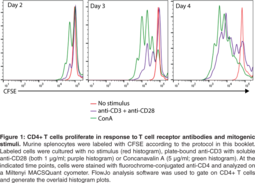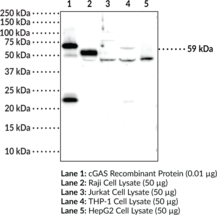Cayman
Showing 14851–15000 of 45550 results
-
CFDA-SE is a stable, cell-permeable dye that consists of a fluorescein molecule containing two acetate moieties and a succinimidyl ester (SE) functional group.{17820} Upon diffusion into the intracellular environment, the acetate groups are cleaved by cellular esterases leaving CFSE (Item No. 16802), which is fluorescent and not cell permeable.{36590} CFSE covalently couples to intracellular molecules via its succinimidyl group and can be retained in cells for at least eight weeks.{36591} CFDA-SE is often used to assay cell proliferation as it is partitioned with high fidelity between daughter cells for up to eight generational divisions.{17820,17802,21243} CFSE, the cleavage product of CFDA-SE, displays excitation/emission maxima of 491/518 nm, respectively.{36591}
Brand:CaymanSKU:-CFSE is a fluorescent product of CFDA-SE (Item No. 14456) cleavage by intracellular esterases.{36590} CFSE lacks the diacetate groups of CFDA-SE and, as a result, is less cell permeable. CFSE fluorescence is cytoplasmic, and it has excitation/emission maxima of 491 and 518 nm, respectively.{36591} It covalently couples to intracellular molecules via its succinimidyl group and can be retained within cells for at least eight weeks. The dilution of CFSE fluorescence resulting from cell division can be used to analyze cell proliferation.{17820} Its fluorescence can also be used to track cell migration in vivo.{17802}
Brand:CaymanSKU:-Out of stock
CFSE is a fluorescent product of CFDA-SE (Item No. 14456) cleavage by intracellular esterases.{36590} CFSE lacks the diacetate groups of CFDA-SE and, as a result, is less cell permeable. CFSE fluorescence is cytoplasmic, and it has excitation/emission maxima of 491 and 518 nm, respectively.{36591} It covalently couples to intracellular molecules via its succinimidyl group and can be retained within cells for at least eight weeks. The dilution of CFSE fluorescence resulting from cell division can be used to analyze cell proliferation.{17820} Its fluorescence can also be used to track cell migration in vivo.{17802}
Brand:CaymanSKU:-Out of stock
CFSE is a fluorescent product of CFDA-SE (Item No. 14456) cleavage by intracellular esterases.{36590} CFSE lacks the diacetate groups of CFDA-SE and, as a result, is less cell permeable. CFSE fluorescence is cytoplasmic, and it has excitation/emission maxima of 491 and 518 nm, respectively.{36591} It covalently couples to intracellular molecules via its succinimidyl group and can be retained within cells for at least eight weeks. The dilution of CFSE fluorescence resulting from cell division can be used to analyze cell proliferation.{17820} Its fluorescence can also be used to track cell migration in vivo.{17802}
Brand:CaymanSKU:-Out of stock
CFSE is a fluorescent product of CFDA-SE (Item No. 14456) cleavage by intracellular esterases.{36590} CFSE lacks the diacetate groups of CFDA-SE and, as a result, is less cell permeable. CFSE fluorescence is cytoplasmic, and it has excitation/emission maxima of 491 and 518 nm, respectively.{36591} It covalently couples to intracellular molecules via its succinimidyl group and can be retained within cells for at least eight weeks. The dilution of CFSE fluorescence resulting from cell division can be used to analyze cell proliferation.{17820} Its fluorescence can also be used to track cell migration in vivo.{17802}
Brand:CaymanSKU:-Out of stock
Cayman’s CFSE Cell Division Assay Kit provides an easy-to-use format for labeling and tracing cells through successive cell divisions. Carboxyfluorescein diacetate, succinimidyl ester (CFDA-SE) diffuses into cells, where the acetate groups are cleaved to yield a highly fluorescent derivative (CFSE) that is retained in the cell and can be detected by flow cytometry. Cell division results in sequential halving of fluorescence, and up to eight divisions can be monitored before the fluorescence is decreased to the background fluorescence of unstained cells.{17802,17820} The ease of use and lack of cytotoxicity allows monitoring of cellular division over weeks either in vitro or in vivo. The kit contains sufficient reagents for labeling and analyzing up to 7.5×108 cells by flow cytometry. CFSE-labeled cells can be further stained with any fluorochrome compatible with fluorescein for use in flow cytometry.
Brand:CaymanSKU:10009853 - 100 testsAvailable on backorder
The cystic fibrosis (CF) gene encodes a cAMP-regulated chloride channel, the CF transmembrane conductance regulator (CFTR).{25612} CFTR inhibitor II, also known as GlyH-101, is a glycine hydrazide that selectively and reversibly blocks the CFTR channel (Ki = 4.3 µM).{25797,25798} This compound binds to a site at the external pore of CFTR, occluding the pore and rapidly preventing chloride transport.{25797,25798} Intraluminal CFTR inhibitor II greatly reduces intestinal fluid secretion induced by cholera toxin.{25798} It is effective in cells in culture and also in nasal and intestinal epithelia in vivo.{25794,25793,25795,25796}
Brand:CaymanSKU:-The cystic fibrosis (CF) gene encodes a cAMP-regulated chloride channel, the CF transmembrane conductance regulator (CFTR).{25612} CFTR inhibitor II, also known as GlyH-101, is a glycine hydrazide that selectively and reversibly blocks the CFTR channel (Ki = 4.3 µM).{25797,25798} This compound binds to a site at the external pore of CFTR, occluding the pore and rapidly preventing chloride transport.{25797,25798} Intraluminal CFTR inhibitor II greatly reduces intestinal fluid secretion induced by cholera toxin.{25798} It is effective in cells in culture and also in nasal and intestinal epithelia in vivo.{25794,25793,25795,25796}
Brand:CaymanSKU:-The cystic fibrosis (CF) gene encodes a cAMP-regulated chloride channel, the CF transmembrane conductance regulator (CFTR).{25612} CFTR inhibitor II, also known as GlyH-101, is a glycine hydrazide that selectively and reversibly blocks the CFTR channel (Ki = 4.3 µM).{25797,25798} This compound binds to a site at the external pore of CFTR, occluding the pore and rapidly preventing chloride transport.{25797,25798} Intraluminal CFTR inhibitor II greatly reduces intestinal fluid secretion induced by cholera toxin.{25798} It is effective in cells in culture and also in nasal and intestinal epithelia in vivo.{25794,25793,25795,25796}
Brand:CaymanSKU:-The cystic fibrosis (CF) gene encodes a cAMP-regulated chloride channel, the CF transmembrane conductance regulator (CFTR).{25612} CFTR Inhibitor-172 is a thiazolidinone that selectively blocks the CFTR channel (Ki = 300 nM) in a voltage-independent manner.{26516} It appears to directly modulate the gating of chloride at the channel and does not prevent elevation of cAMP or inhibit other pumps or channels.{26516,26514} In mice, CFTR inhibitor-172 prevents cholera toxin-induced fluid secretion in the small intestine, when given by intraperitoneal injection.{26516,25797} It slows cyst growth in animal models of polycystic kidney disease.{26515} As CFTR also modulates glutathione (GSH) efflux, CFTR inhibitor-172 can affect intracellular GSH concentration and reactive oxygen species balance.{26511,26512,26513}
Brand:CaymanSKU:-The cystic fibrosis (CF) gene encodes a cAMP-regulated chloride channel, the CF transmembrane conductance regulator (CFTR).{25612} CFTR Inhibitor-172 is a thiazolidinone that selectively blocks the CFTR channel (Ki = 300 nM) in a voltage-independent manner.{26516} It appears to directly modulate the gating of chloride at the channel and does not prevent elevation of cAMP or inhibit other pumps or channels.{26516,26514} In mice, CFTR inhibitor-172 prevents cholera toxin-induced fluid secretion in the small intestine, when given by intraperitoneal injection.{26516,25797} It slows cyst growth in animal models of polycystic kidney disease.{26515} As CFTR also modulates glutathione (GSH) efflux, CFTR inhibitor-172 can affect intracellular GSH concentration and reactive oxygen species balance.{26511,26512,26513}
Brand:CaymanSKU:-The cystic fibrosis (CF) gene encodes a cAMP-regulated chloride channel, the CF transmembrane conductance regulator (CFTR).{25612} CFTR Inhibitor-172 is a thiazolidinone that selectively blocks the CFTR channel (Ki = 300 nM) in a voltage-independent manner.{26516} It appears to directly modulate the gating of chloride at the channel and does not prevent elevation of cAMP or inhibit other pumps or channels.{26516,26514} In mice, CFTR inhibitor-172 prevents cholera toxin-induced fluid secretion in the small intestine, when given by intraperitoneal injection.{26516,25797} It slows cyst growth in animal models of polycystic kidney disease.{26515} As CFTR also modulates glutathione (GSH) efflux, CFTR inhibitor-172 can affect intracellular GSH concentration and reactive oxygen species balance.{26511,26512,26513}
Brand:CaymanSKU:-The cystic fibrosis (CF) gene encodes a cAMP-regulated chloride channel, the CF transmembrane conductance regulator (CFTR).{25612} CFTR Inhibitor-172 is a thiazolidinone that selectively blocks the CFTR channel (Ki = 300 nM) in a voltage-independent manner.{26516} It appears to directly modulate the gating of chloride at the channel and does not prevent elevation of cAMP or inhibit other pumps or channels.{26516,26514} In mice, CFTR inhibitor-172 prevents cholera toxin-induced fluid secretion in the small intestine, when given by intraperitoneal injection.{26516,25797} It slows cyst growth in animal models of polycystic kidney disease.{26515} As CFTR also modulates glutathione (GSH) efflux, CFTR inhibitor-172 can affect intracellular GSH concentration and reactive oxygen species balance.{26511,26512,26513}
Brand:CaymanSKU:-Cyclic GMP-AMP (cGAMP) synthase (cGAS; Item No. 22810) is a nucleotidyltransferase located in the cytosol that acts as a cytosolic DNA sensor to detect foreign DNA from microbial pathogens as part of the innate immune response.{22400,22401} Upon binding to cytosolic DNA, cGAS produces the cyclic dinucleotide second messenger cGAMP, which activates stimulator of interferon genes (STING), leading to activation of the type I interferon (IFN) pathway.{22400,22401,39161} In vitro, fibroblasts, macrophages, and dendritic cells isolated from cGAS knockout (cGAS-/-) mice do not produce type I IFNs following DNA transfection or DNA virus infection.{39163} Similarly, cells containing a frame-shift mutation in the cGAS locus fail to mount an immune response to HIV and other retroviruses.{39164} In vivo, cGAS-/- mice infected with herpes simplex virus 1 (HSV-1) have lower levels of IFN-α and IFN-β, shorter survival times, and higher post-mortem levels of HSV-1 in the brain.{39163} Cayman’s cGAS Monoclonal Antibody (Clone 5G10) recognizes the full length human cGAS protein at ~59 kDa.
Brand:CaymanSKU:23853 - 300 µgAvailable on backorder
Immunogen: Full length human recombinant protein • Host: Mouse, clone 5G10 • Species Reactivity: (+) Human cGAS • Application(s): WB, IF, and IP
Brand:CaymanSKU:23853- 300 µgAvailable on backorder
Immunogen: Full length human recombinant protein • Host: Mouse, clone 5G10 • Species Reactivity: (+) Human cGAS • Application(s): WB, IF, and IP
Brand:CaymanSKU:23853- 300 µgCGI1746 is a potent, selective inhibitor of Bruton’s tyrosine kinase (BTK; IC50 = 1.9 nM), a non-receptor tyrosine kinase that is important in B lymphocyte development.{32058,30641} It blocks both auto-and trans-phosphorylation of BTK by occupying an SH3 binding pocket in the un-phosphorylated enzyme. CGI1746 prevents B-cell antigen receptor-mediated B lymphocyte proliferation and suppresses FCγRIII-induced TNFα, IL-1β, and IL-6 production in macrophages.{32058} It reduces cytokine levels within joints and ameliorates symptoms in a mouse model of autoantibody-induced arthritis.{32058}
Brand:CaymanSKU:-Available on backorder
CGI1746 is a potent, selective inhibitor of Bruton’s tyrosine kinase (BTK; IC50 = 1.9 nM), a non-receptor tyrosine kinase that is important in B lymphocyte development.{32058,30641} It blocks both auto-and trans-phosphorylation of BTK by occupying an SH3 binding pocket in the un-phosphorylated enzyme. CGI1746 prevents B-cell antigen receptor-mediated B lymphocyte proliferation and suppresses FCγRIII-induced TNFα, IL-1β, and IL-6 production in macrophages.{32058} It reduces cytokine levels within joints and ameliorates symptoms in a mouse model of autoantibody-induced arthritis.{32058}
Brand:CaymanSKU:-Available on backorder
CGI1746 is a potent, selective inhibitor of Bruton’s tyrosine kinase (BTK; IC50 = 1.9 nM), a non-receptor tyrosine kinase that is important in B lymphocyte development.{32058,30641} It blocks both auto-and trans-phosphorylation of BTK by occupying an SH3 binding pocket in the un-phosphorylated enzyme. CGI1746 prevents B-cell antigen receptor-mediated B lymphocyte proliferation and suppresses FCγRIII-induced TNFα, IL-1β, and IL-6 production in macrophages.{32058} It reduces cytokine levels within joints and ameliorates symptoms in a mouse model of autoantibody-induced arthritis.{32058}
Brand:CaymanSKU:-Available on backorder
CGI1746 is a potent, selective inhibitor of Bruton’s tyrosine kinase (BTK; IC50 = 1.9 nM), a non-receptor tyrosine kinase that is important in B lymphocyte development.{32058,30641} It blocks both auto-and trans-phosphorylation of BTK by occupying an SH3 binding pocket in the un-phosphorylated enzyme. CGI1746 prevents B-cell antigen receptor-mediated B lymphocyte proliferation and suppresses FCγRIII-induced TNFα, IL-1β, and IL-6 production in macrophages.{32058} It reduces cytokine levels within joints and ameliorates symptoms in a mouse model of autoantibody-induced arthritis.{32058}
Brand:CaymanSKU:-Available on backorder
Ataxia-telangiectasia mutated (ATM) and ATM- and Rad3-related (ATR) kinases mediate the DNA damage response pathway in cells upon encounter with genotoxic agents. Their signaling can activate cell cycle arrest, DNA repair, induction of premature senescence, and cell death. Inhibiting this pathway is one strategy implemented to increase the therapeutic capacity of certain genotoxic anti-cancer regimens by sensitizing cancer cells to these agents.{27525,26648} CGK733, a thiourea-containing compound, was originally identified as a specific inhibitor of ATR and ATM kinases (IC50 = ~ 200 nM).{27525} In prematurely senescent breast, lung, and colon cancer cells CGK733 reportedly suppresses ATM-mediated p21 expression required for survival, resulting in cell death.{26648} Human cancer cell lines exposed to both caffeine and CGK733 demonstrate a rapid decline in cyclin D1 protein levels and a reduction in retinoblastoma protein levels, which leads to the inhibition of their proliferation.{27525}
Brand:CaymanSKU:-Ataxia-telangiectasia mutated (ATM) and ATM- and Rad3-related (ATR) kinases mediate the DNA damage response pathway in cells upon encounter with genotoxic agents. Their signaling can activate cell cycle arrest, DNA repair, induction of premature senescence, and cell death. Inhibiting this pathway is one strategy implemented to increase the therapeutic capacity of certain genotoxic anti-cancer regimens by sensitizing cancer cells to these agents.{27525,26648} CGK733, a thiourea-containing compound, was originally identified as a specific inhibitor of ATR and ATM kinases (IC50 = ~ 200 nM).{27525} In prematurely senescent breast, lung, and colon cancer cells CGK733 reportedly suppresses ATM-mediated p21 expression required for survival, resulting in cell death.{26648} Human cancer cell lines exposed to both caffeine and CGK733 demonstrate a rapid decline in cyclin D1 protein levels and a reduction in retinoblastoma protein levels, which leads to the inhibition of their proliferation.{27525}
Brand:CaymanSKU:-Ataxia-telangiectasia mutated (ATM) and ATM- and Rad3-related (ATR) kinases mediate the DNA damage response pathway in cells upon encounter with genotoxic agents. Their signaling can activate cell cycle arrest, DNA repair, induction of premature senescence, and cell death. Inhibiting this pathway is one strategy implemented to increase the therapeutic capacity of certain genotoxic anti-cancer regimens by sensitizing cancer cells to these agents.{27525,26648} CGK733, a thiourea-containing compound, was originally identified as a specific inhibitor of ATR and ATM kinases (IC50 = ~ 200 nM).{27525} In prematurely senescent breast, lung, and colon cancer cells CGK733 reportedly suppresses ATM-mediated p21 expression required for survival, resulting in cell death.{26648} Human cancer cell lines exposed to both caffeine and CGK733 demonstrate a rapid decline in cyclin D1 protein levels and a reduction in retinoblastoma protein levels, which leads to the inhibition of their proliferation.{27525}
Brand:CaymanSKU:-Ataxia-telangiectasia mutated (ATM) and ATM- and Rad3-related (ATR) kinases mediate the DNA damage response pathway in cells upon encounter with genotoxic agents. Their signaling can activate cell cycle arrest, DNA repair, induction of premature senescence, and cell death. Inhibiting this pathway is one strategy implemented to increase the therapeutic capacity of certain genotoxic anti-cancer regimens by sensitizing cancer cells to these agents.{27525,26648} CGK733, a thiourea-containing compound, was originally identified as a specific inhibitor of ATR and ATM kinases (IC50 = ~ 200 nM).{27525} In prematurely senescent breast, lung, and colon cancer cells CGK733 reportedly suppresses ATM-mediated p21 expression required for survival, resulting in cell death.{26648} Human cancer cell lines exposed to both caffeine and CGK733 demonstrate a rapid decline in cyclin D1 protein levels and a reduction in retinoblastoma protein levels, which leads to the inhibition of their proliferation.{27525}
Brand:CaymanSKU:-CGP 3466 is a GAPDH ligand.{37164,37165} Immobilized CGP 3466 binds to GAPDH from rat hippocampus extracts and to purified recombinant rabbit muscle GAPDH using affinity purification.{37165} CGP 3466 reduces PAJU cell apoptosis induced by rotenone (Item No. 13995). CGP 3466 dose-dependently increases survival of trophically withdrawn PC12 cells, decreases cytosine arabinoside-induced apoptosis of cerebellar granule cells, and increases the number of tyrosine hydroxylase-positive (TH+) mesencephalic dopaminergic neurons in vitro.{37164} Oral administration of CGP 3466 (0.14 mg/kg) increases the number of TH+ dopaminergic neurons in a rat model of Parkinson’s disease induced by MPTP. It also reduces delayed acquisition in the Morris maze in a 6-OHDA-treated rat model of Parkinson’s disease and increases survival in progressive motor neuronopathy (pmn) mice, a genetic model of amyotrophic lateral sclerosis (ALS). Formulations containing CGP 3466 are under clinical investigation for the treatment of Parkinson’s disease and ALS.{37166,37167}
Brand:CaymanSKU:23362 - 1 mgAvailable on backorder
CGP 3466 is a GAPDH ligand.{37164,37165} Immobilized CGP 3466 binds to GAPDH from rat hippocampus extracts and to purified recombinant rabbit muscle GAPDH using affinity purification.{37165} CGP 3466 reduces PAJU cell apoptosis induced by rotenone (Item No. 13995). CGP 3466 dose-dependently increases survival of trophically withdrawn PC12 cells, decreases cytosine arabinoside-induced apoptosis of cerebellar granule cells, and increases the number of tyrosine hydroxylase-positive (TH+) mesencephalic dopaminergic neurons in vitro.{37164} Oral administration of CGP 3466 (0.14 mg/kg) increases the number of TH+ dopaminergic neurons in a rat model of Parkinson’s disease induced by MPTP. It also reduces delayed acquisition in the Morris maze in a 6-OHDA-treated rat model of Parkinson’s disease and increases survival in progressive motor neuronopathy (pmn) mice, a genetic model of amyotrophic lateral sclerosis (ALS). Formulations containing CGP 3466 are under clinical investigation for the treatment of Parkinson’s disease and ALS.{37166,37167}
Brand:CaymanSKU:23362 - 5 mgAvailable on backorder
The amino acid γ-aminobutyric acid (GABA) is an inhibitory neurotransmitter that acts through two families of heteromeric ligand-gated ion channels, GABAA and GABAC, and a G protein-coupled receptor, GABAB. CGP 35348 is a selective, brain-accessible GABAB receptor antagonist (IC50 = 34 µM).{30403} It blocks the action of the GABAB-selective agonist baclofen (Item No. 18600) at postsynaptic sites but not at presynaptic receptors.{30403,30400} CGP 35348 prevents baclofen-induced antinociception and muscle relaxation in mice and rats.{30402} It is commonly used to investigate the role of GABAB activation in neurological signaling.{30401,30399,30398}
Brand:CaymanSKU:-Available on backorder
The amino acid γ-aminobutyric acid (GABA) is an inhibitory neurotransmitter that acts through two families of heteromeric ligand-gated ion channels, GABAA and GABAC, and a G protein-coupled receptor, GABAB. CGP 35348 is a selective, brain-accessible GABAB receptor antagonist (IC50 = 34 µM).{30403} It blocks the action of the GABAB-selective agonist baclofen (Item No. 18600) at postsynaptic sites but not at presynaptic receptors.{30403,30400} CGP 35348 prevents baclofen-induced antinociception and muscle relaxation in mice and rats.{30402} It is commonly used to investigate the role of GABAB activation in neurological signaling.{30401,30399,30398}
Brand:CaymanSKU:-Available on backorder
CGP 36216 is a selective antagonist of GABAB receptors (IC50 = 43 µM).{28184,28183} Its action is reversed by the GABAB receptor agonist baclofen.{28183} It is active at presynaptic, but not postsynaptic, receptors.{28183}
Brand:CaymanSKU:11985 - 1 mgAvailable on backorder
CGP 36216 is a selective antagonist of GABAB receptors (IC50 = 43 µM).{28184,28183} Its action is reversed by the GABAB receptor agonist baclofen.{28183} It is active at presynaptic, but not postsynaptic, receptors.{28183}
Brand:CaymanSKU:11985 - 10 mgAvailable on backorder
CGP 36216 is a selective antagonist of GABAB receptors (IC50 = 43 µM).{28184,28183} Its action is reversed by the GABAB receptor agonist baclofen.{28183} It is active at presynaptic, but not postsynaptic, receptors.{28183}
Brand:CaymanSKU:11985 - 5 mgAvailable on backorder
CGP 37157 is a benzothiazepine that acts as a selective inhibitor of the mitochondrial sodium-calcium exchanger (IC50 = 0.36 μM in isolated mitochondria).{25544} It does not affect channels, exchangers, or ATPases on the cardiac sarcolemma or ATPases on sarcoplasmic reticulum.{25544} CGP 37157 is commonly used to study the role of mitochondrial-derived calcium in cytoplasmic calcium homeostasis.{25548,25547} CGP 37157 inhibits sodium-dependent calcium efflux via the mitochondrial exchanger NCLX in a variety of cell types (IC50 = 5 μM).{25545,25546}
Brand:CaymanSKU:-CGP 37157 is a benzothiazepine that acts as a selective inhibitor of the mitochondrial sodium-calcium exchanger (IC50 = 0.36 μM in isolated mitochondria).{25544} It does not affect channels, exchangers, or ATPases on the cardiac sarcolemma or ATPases on sarcoplasmic reticulum.{25544} CGP 37157 is commonly used to study the role of mitochondrial-derived calcium in cytoplasmic calcium homeostasis.{25548,25547} CGP 37157 inhibits sodium-dependent calcium efflux via the mitochondrial exchanger NCLX in a variety of cell types (IC50 = 5 μM).{25545,25546}
Brand:CaymanSKU:-CGP 52432 is an antagonist of GABAB receptors.{48167} It selectively reverses (–)-baclofen-induced inhibition of potassium-evoked GABA release over glutamate or somatostatin release (IC50s = 0.085, 3.35, and 9.26 μM, respectively) from rat cortical synaptosomes. CGP 52432 (10 μM) reduces paired-pulse inhibition of monosynaptic inhibitory potentials (IPSPs) by 80% in CA1 pyramidal neurons in rat hippocampal slices.{48168} It increases cell proliferation in the ventral subgranular zone of the dentate gyrus when administered at a dose of 3 mg/kg per day for 21 days and reduces immobility in the forced-swim test when administered at 10 mg/kg in stress-sensitive BALB/c mice.{48169} CGP 52432 (30 mg/kg) increases locomotor activity in mice.{48170} It also inhibits the analgesic effects of isovaline, GABA, and baclofen (Item No. 18600) in a mouse model of hindpaw allodynia induced by prostaglandin E2 (PGE2; Item No. 14010).{48171}
Brand:CaymanSKU:27212 - 10 mgAvailable on backorder
CGP 52432 is an antagonist of GABAB receptors.{48167} It selectively reverses (–)-baclofen-induced inhibition of potassium-evoked GABA release over glutamate or somatostatin release (IC50s = 0.085, 3.35, and 9.26 μM, respectively) from rat cortical synaptosomes. CGP 52432 (10 μM) reduces paired-pulse inhibition of monosynaptic inhibitory potentials (IPSPs) by 80% in CA1 pyramidal neurons in rat hippocampal slices.{48168} It increases cell proliferation in the ventral subgranular zone of the dentate gyrus when administered at a dose of 3 mg/kg per day for 21 days and reduces immobility in the forced-swim test when administered at 10 mg/kg in stress-sensitive BALB/c mice.{48169} CGP 52432 (30 mg/kg) increases locomotor activity in mice.{48170} It also inhibits the analgesic effects of isovaline, GABA, and baclofen (Item No. 18600) in a mouse model of hindpaw allodynia induced by prostaglandin E2 (PGE2; Item No. 14010).{48171}
Brand:CaymanSKU:27212 - 25 mgAvailable on backorder
CGP 52432 is an antagonist of GABAB receptors.{48167} It selectively reverses (–)-baclofen-induced inhibition of potassium-evoked GABA release over glutamate or somatostatin release (IC50s = 0.085, 3.35, and 9.26 μM, respectively) from rat cortical synaptosomes. CGP 52432 (10 μM) reduces paired-pulse inhibition of monosynaptic inhibitory potentials (IPSPs) by 80% in CA1 pyramidal neurons in rat hippocampal slices.{48168} It increases cell proliferation in the ventral subgranular zone of the dentate gyrus when administered at a dose of 3 mg/kg per day for 21 days and reduces immobility in the forced-swim test when administered at 10 mg/kg in stress-sensitive BALB/c mice.{48169} CGP 52432 (30 mg/kg) increases locomotor activity in mice.{48170} It also inhibits the analgesic effects of isovaline, GABA, and baclofen (Item No. 18600) in a mouse model of hindpaw allodynia induced by prostaglandin E2 (PGE2; Item No. 14010).{48171}
Brand:CaymanSKU:27212 - 5 mgAvailable on backorder
CGP 52432 is an antagonist of GABAB receptors.{48167} It selectively reverses (–)-baclofen-induced inhibition of potassium-evoked GABA release over glutamate or somatostatin release (IC50s = 0.085, 3.35, and 9.26 μM, respectively) from rat cortical synaptosomes. CGP 52432 (10 μM) reduces paired-pulse inhibition of monosynaptic inhibitory potentials (IPSPs) by 80% in CA1 pyramidal neurons in rat hippocampal slices.{48168} It increases cell proliferation in the ventral subgranular zone of the dentate gyrus when administered at a dose of 3 mg/kg per day for 21 days and reduces immobility in the forced-swim test when administered at 10 mg/kg in stress-sensitive BALB/c mice.{48169} CGP 52432 (30 mg/kg) increases locomotor activity in mice.{48170} It also inhibits the analgesic effects of isovaline, GABA, and baclofen (Item No. 18600) in a mouse model of hindpaw allodynia induced by prostaglandin E2 (PGE2; Item No. 14010).{48171}
Brand:CaymanSKU:27212 - 50 mgAvailable on backorder
CGP 54626 is a selective antagonist of the GABAB receptor with an IC50 value of 4 nM.{32581} It can be used to investigate the role of GABAB receptors in neurological signaling.
Brand:CaymanSKU:20121 -Available on backorder
CGP 54626 is a selective antagonist of the GABAB receptor with an IC50 value of 4 nM.{32581} It can be used to investigate the role of GABAB receptors in neurological signaling.
Brand:CaymanSKU:20121 -Available on backorder
CGP 54626 is a selective antagonist of the GABAB receptor with an IC50 value of 4 nM.{32581} It can be used to investigate the role of GABAB receptors in neurological signaling.
Brand:CaymanSKU:20121 -Available on backorder
CGP 54626 is a selective antagonist of the GABAB receptor with an IC50 value of 4 nM.{32581} It can be used to investigate the role of GABAB receptors in neurological signaling.
Brand:CaymanSKU:20121 -Available on backorder
CGP 57380 is a selective inhibitor of MAP kinase-interacting kinase 1 (MNK1) in vitro (IC50 = 2.2 μM),{17271} with no inhibitory activity against p38, JNK1, ERK1/2, PKC, or Src-like kinases. It blocks the phosphorylation of eIF4E in response to TNF-α, arsenite, anisomycin, PMA, or fetal calf serum in 293 cells (IC50 = 3 μM).{17271} CGP 57380 also dose-dependently inhibits TNF-α production in RAW 264.7 cells that have been co-treated with agonists for Toll-like receptor (TLR)2 (HKLM), TLR4 (LPS), TLR6/2 (FSL), TLR7 (imiquimod), or TLR9 (CpG DNA), presumably by inhibiting MNK1.{17272}
Brand:CaymanSKU:-CGP 57380 is a selective inhibitor of MAP kinase-interacting kinase 1 (MNK1) in vitro (IC50 = 2.2 μM),{17271} with no inhibitory activity against p38, JNK1, ERK1/2, PKC, or Src-like kinases. It blocks the phosphorylation of eIF4E in response to TNF-α, arsenite, anisomycin, PMA, or fetal calf serum in 293 cells (IC50 = 3 μM).{17271} CGP 57380 also dose-dependently inhibits TNF-α production in RAW 264.7 cells that have been co-treated with agonists for Toll-like receptor (TLR)2 (HKLM), TLR4 (LPS), TLR6/2 (FSL), TLR7 (imiquimod), or TLR9 (CpG DNA), presumably by inhibiting MNK1.{17272}
Brand:CaymanSKU:-CGP 57380 is a selective inhibitor of MAP kinase-interacting kinase 1 (MNK1) in vitro (IC50 = 2.2 μM),{17271} with no inhibitory activity against p38, JNK1, ERK1/2, PKC, or Src-like kinases. It blocks the phosphorylation of eIF4E in response to TNF-α, arsenite, anisomycin, PMA, or fetal calf serum in 293 cells (IC50 = 3 μM).{17271} CGP 57380 also dose-dependently inhibits TNF-α production in RAW 264.7 cells that have been co-treated with agonists for Toll-like receptor (TLR)2 (HKLM), TLR4 (LPS), TLR6/2 (FSL), TLR7 (imiquimod), or TLR9 (CpG DNA), presumably by inhibiting MNK1.{17272}
Brand:CaymanSKU:-CGP 57380 is a selective inhibitor of MAP kinase-interacting kinase 1 (MNK1) in vitro (IC50 = 2.2 μM),{17271} with no inhibitory activity against p38, JNK1, ERK1/2, PKC, or Src-like kinases. It blocks the phosphorylation of eIF4E in response to TNF-α, arsenite, anisomycin, PMA, or fetal calf serum in 293 cells (IC50 = 3 μM).{17271} CGP 57380 also dose-dependently inhibits TNF-α production in RAW 264.7 cells that have been co-treated with agonists for Toll-like receptor (TLR)2 (HKLM), TLR4 (LPS), TLR6/2 (FSL), TLR7 (imiquimod), or TLR9 (CpG DNA), presumably by inhibiting MNK1.{17272}
Brand:CaymanSKU:-CGP 60474 is an inhibitor of cyclin-dependent kinases (CDKs; IC50s = 0.017, 0.08, and 0.05 µM for Cdk1/cyclin B, Cdk2/cyclin A, and Cdk2/cyclin E, respectively).{61149} It is selective for these CDKs over Cdk4/cyclin D1 (IC50 = 0.7 µM) and a variety of other kinases, including several PKC isoforms (IC50s = 1.9->100 µM), PKA (IC50 = 160 µM), and FLT1 (IC50 = 1 µM), among others, but does inhibit PKCα and v-Abl (IC50s = 0.25 and 0.4 µM, respectively). It inhibits proliferation of colon, breast, lung, prostate, and ovarian cancer cells (IC50s = 25-84, 21-280, 40 and 68, 17 and 20, and 18-38 nM, respectively). CGP 60474 also reduces LPS-induced IL-6, TNF-α, and RANTES secretion from J774.1 cells in a concentration-dependent manner and inhibits poly(I:C)-induced NF-κB nuclear translocation in the same cells when used at concentrations of 8 and 32 nM.{61150} It reduces plasma IL-6 levels and increases survival in a mouse model of LPS-induced endotoxemia when administered at a dose of 10 mg/kg.
Brand:CaymanSKU:29631 - 1 mgAvailable on backorder
CGP 60474 is an inhibitor of cyclin-dependent kinases (CDKs; IC50s = 0.017, 0.08, and 0.05 µM for Cdk1/cyclin B, Cdk2/cyclin A, and Cdk2/cyclin E, respectively).{61149} It is selective for these CDKs over Cdk4/cyclin D1 (IC50 = 0.7 µM) and a variety of other kinases, including several PKC isoforms (IC50s = 1.9->100 µM), PKA (IC50 = 160 µM), and FLT1 (IC50 = 1 µM), among others, but does inhibit PKCα and v-Abl (IC50s = 0.25 and 0.4 µM, respectively). It inhibits proliferation of colon, breast, lung, prostate, and ovarian cancer cells (IC50s = 25-84, 21-280, 40 and 68, 17 and 20, and 18-38 nM, respectively). CGP 60474 also reduces LPS-induced IL-6, TNF-α, and RANTES secretion from J774.1 cells in a concentration-dependent manner and inhibits poly(I:C)-induced NF-κB nuclear translocation in the same cells when used at concentrations of 8 and 32 nM.{61150} It reduces plasma IL-6 levels and increases survival in a mouse model of LPS-induced endotoxemia when administered at a dose of 10 mg/kg.
Brand:CaymanSKU:29631 - 10 mgAvailable on backorder
CGP 60474 is an inhibitor of cyclin-dependent kinases (CDKs; IC50s = 0.017, 0.08, and 0.05 µM for Cdk1/cyclin B, Cdk2/cyclin A, and Cdk2/cyclin E, respectively).{61149} It is selective for these CDKs over Cdk4/cyclin D1 (IC50 = 0.7 µM) and a variety of other kinases, including several PKC isoforms (IC50s = 1.9->100 µM), PKA (IC50 = 160 µM), and FLT1 (IC50 = 1 µM), among others, but does inhibit PKCα and v-Abl (IC50s = 0.25 and 0.4 µM, respectively). It inhibits proliferation of colon, breast, lung, prostate, and ovarian cancer cells (IC50s = 25-84, 21-280, 40 and 68, 17 and 20, and 18-38 nM, respectively). CGP 60474 also reduces LPS-induced IL-6, TNF-α, and RANTES secretion from J774.1 cells in a concentration-dependent manner and inhibits poly(I:C)-induced NF-κB nuclear translocation in the same cells when used at concentrations of 8 and 32 nM.{61150} It reduces plasma IL-6 levels and increases survival in a mouse model of LPS-induced endotoxemia when administered at a dose of 10 mg/kg.
Brand:CaymanSKU:29631 - 5 mgAvailable on backorder
CGP 71683 is an antagonist of neuropeptide Y (NPY) receptor Y5 (IC50 = 1.4 nM in a radioligand binding assay).{52105} It is selective for Y5 over Y1, Y2, and Y4 receptors (IC50s = 2,765, 7,187, and 5,637 nM, respectively). It inhibits NPY-induced increases in BT-549 cell growth and MDA-MB-231 cell migration when used at a concentration of 0.25 μM.{52104} CGP 71683 (10 mg/kg, i.p.) inhibits increases in food intake induced by intracerebroventricular administration of NPY in rats.{52105}
Brand:CaymanSKU:28778 - 1 mgAvailable on backorder
CGP 71683 is an antagonist of neuropeptide Y (NPY) receptor Y5 (IC50 = 1.4 nM in a radioligand binding assay).{52105} It is selective for Y5 over Y1, Y2, and Y4 receptors (IC50s = 2,765, 7,187, and 5,637 nM, respectively). It inhibits NPY-induced increases in BT-549 cell growth and MDA-MB-231 cell migration when used at a concentration of 0.25 μM.{52104} CGP 71683 (10 mg/kg, i.p.) inhibits increases in food intake induced by intracerebroventricular administration of NPY in rats.{52105}
Brand:CaymanSKU:28778 - 10 mgAvailable on backorder
CGP 71683 is an antagonist of neuropeptide Y (NPY) receptor Y5 (IC50 = 1.4 nM in a radioligand binding assay).{52105} It is selective for Y5 over Y1, Y2, and Y4 receptors (IC50s = 2,765, 7,187, and 5,637 nM, respectively). It inhibits NPY-induced increases in BT-549 cell growth and MDA-MB-231 cell migration when used at a concentration of 0.25 μM.{52104} CGP 71683 (10 mg/kg, i.p.) inhibits increases in food intake induced by intracerebroventricular administration of NPY in rats.{52105}
Brand:CaymanSKU:28778 - 5 mgAvailable on backorder
CGP 77675 is an inhibitor of Src family kinases (SFKs) that blocks the phosphorylation of peptide substrates and autophosphorylation of purified c-Src (IC50s = 5-20 and 40 nM, respectively).{33451} It also inhibits the SFKs Lck and c-Yes with low nanomolar IC50 values.{33451,33450,33453} CGP 77675 is used to elucidate the role of SFKs in such processes as bone resorption, tight junction formation in epithelial cells, and allograft survival.{33450,33451,33454} It can also be used in combination with the GSK3 inhibitor CHIR99021 (Item No. 13122) to maintain mouse embryonic stem cells.{33452}
Brand:CaymanSKU:21089 -Out of stock
CGP 77675 is an inhibitor of Src family kinases (SFKs) that blocks the phosphorylation of peptide substrates and autophosphorylation of purified c-Src (IC50s = 5-20 and 40 nM, respectively).{33451} It also inhibits the SFKs Lck and c-Yes with low nanomolar IC50 values.{33451,33450,33453} CGP 77675 is used to elucidate the role of SFKs in such processes as bone resorption, tight junction formation in epithelial cells, and allograft survival.{33450,33451,33454} It can also be used in combination with the GSK3 inhibitor CHIR99021 (Item No. 13122) to maintain mouse embryonic stem cells.{33452}
Brand:CaymanSKU:21089 -Out of stock
CGP 77675 is an inhibitor of Src family kinases (SFKs) that blocks the phosphorylation of peptide substrates and autophosphorylation of purified c-Src (IC50s = 5-20 and 40 nM, respectively).{33451} It also inhibits the SFKs Lck and c-Yes with low nanomolar IC50 values.{33451,33450,33453} CGP 77675 is used to elucidate the role of SFKs in such processes as bone resorption, tight junction formation in epithelial cells, and allograft survival.{33450,33451,33454} It can also be used in combination with the GSK3 inhibitor CHIR99021 (Item No. 13122) to maintain mouse embryonic stem cells.{33452}
Brand:CaymanSKU:21089 -Out of stock
CGP 77675 is an inhibitor of Src family kinases (SFKs) that blocks the phosphorylation of peptide substrates and autophosphorylation of purified c-Src (IC50s = 5-20 and 40 nM, respectively).{33451} It also inhibits the SFKs Lck and c-Yes with low nanomolar IC50 values.{33451,33450,33453} CGP 77675 is used to elucidate the role of SFKs in such processes as bone resorption, tight junction formation in epithelial cells, and allograft survival.{33450,33451,33454} It can also be used in combination with the GSK3 inhibitor CHIR99021 (Item No. 13122) to maintain mouse embryonic stem cells.{33452}
Brand:CaymanSKU:21089 -Out of stock
CGP 7930 is a positive allosteric modulator of GABAB receptors.{45680} It enhances GABA binding with a maximal effect of 143% compared to a GABA-only control in CHO cells membranes expressing the GABAB(1b/2) receptor and enhances GABA binding to rat cortical membranes when used at a concentration of 30 µM. It is selective for GABA binding to heterodimeric GABAB(1b/2) over monomeric GABAB(1b) receptors. CGP 7930 potentiates the efficacy of the GABAB receptor agonist baclofen (Item No. 27326) in decreasing the spontaneous firing rate of dopaminergic neurons in the rat ventral tegmental area (VTA) in vitro (EC50 = 0.27 µM).{45681} It also potentiates the sedative-reducing effects induced by the GABAB receptor agonists baclofen and γ-hydroxybutyric acid (GHB) in rats when administered at doses ranging from 10 to 170 mg/kg, effects that can be blocked by the GABAB receptor antagonist SCH 50911.{45682} CGP 7930 reduces self-administration of nicotine, alcohol, and cocaine in rodent models.{45683} It suppresses the acquisition of alcohol drinking behavior in alcohol-naïve Sardinian alcohol-preferring rats over a five-day period when administered at doses ranging from 25 to 100 mg/kg and transiently reduces the maintenance of alcohol drinking behavior in alcohol-experienced rats at a dose of 100 mg/kg.{45684}
Brand:CaymanSKU:29429 - 1 mgAvailable on backorder
CGP 7930 is a positive allosteric modulator of GABAB receptors.{45680} It enhances GABA binding with a maximal effect of 143% compared to a GABA-only control in CHO cells membranes expressing the GABAB(1b/2) receptor and enhances GABA binding to rat cortical membranes when used at a concentration of 30 µM. It is selective for GABA binding to heterodimeric GABAB(1b/2) over monomeric GABAB(1b) receptors. CGP 7930 potentiates the efficacy of the GABAB receptor agonist baclofen (Item No. 27326) in decreasing the spontaneous firing rate of dopaminergic neurons in the rat ventral tegmental area (VTA) in vitro (EC50 = 0.27 µM).{45681} It also potentiates the sedative-reducing effects induced by the GABAB receptor agonists baclofen and γ-hydroxybutyric acid (GHB) in rats when administered at doses ranging from 10 to 170 mg/kg, effects that can be blocked by the GABAB receptor antagonist SCH 50911.{45682} CGP 7930 reduces self-administration of nicotine, alcohol, and cocaine in rodent models.{45683} It suppresses the acquisition of alcohol drinking behavior in alcohol-naïve Sardinian alcohol-preferring rats over a five-day period when administered at doses ranging from 25 to 100 mg/kg and transiently reduces the maintenance of alcohol drinking behavior in alcohol-experienced rats at a dose of 100 mg/kg.{45684}
Brand:CaymanSKU:29429 - 10 mgAvailable on backorder
CGP 7930 is a positive allosteric modulator of GABAB receptors.{45680} It enhances GABA binding with a maximal effect of 143% compared to a GABA-only control in CHO cells membranes expressing the GABAB(1b/2) receptor and enhances GABA binding to rat cortical membranes when used at a concentration of 30 µM. It is selective for GABA binding to heterodimeric GABAB(1b/2) over monomeric GABAB(1b) receptors. CGP 7930 potentiates the efficacy of the GABAB receptor agonist baclofen (Item No. 27326) in decreasing the spontaneous firing rate of dopaminergic neurons in the rat ventral tegmental area (VTA) in vitro (EC50 = 0.27 µM).{45681} It also potentiates the sedative-reducing effects induced by the GABAB receptor agonists baclofen and γ-hydroxybutyric acid (GHB) in rats when administered at doses ranging from 10 to 170 mg/kg, effects that can be blocked by the GABAB receptor antagonist SCH 50911.{45682} CGP 7930 reduces self-administration of nicotine, alcohol, and cocaine in rodent models.{45683} It suppresses the acquisition of alcohol drinking behavior in alcohol-naïve Sardinian alcohol-preferring rats over a five-day period when administered at doses ranging from 25 to 100 mg/kg and transiently reduces the maintenance of alcohol drinking behavior in alcohol-experienced rats at a dose of 100 mg/kg.{45684}
Brand:CaymanSKU:29429 - 5 mgAvailable on backorder
Immunogen: Rat α-CGRP • Host: Mouse, clone 4901 • Species Reactivity: (+) Rat α-CGRP, Rat β-CGRP, Human α-CGRP • Applications: ICC ,,
Brand:CaymanSKU:29254- 100 µlCalcitonin gene-related peptide (CGRP) is a 37-amino acid neuropeptide.{41395} It exists in two major forms that share greater than 90% sequence homology, α-CGRP that is produced by alternative RNA splicing of the calcitonin gene CALCI and β-CGRP that is encoded by CALCII in humans. CGRP is primarily expressed in A and Cδ fibers and exhibits perivascular localization but is also expressed in keratinocytes and endothelial progenitor cells.{41395,53682} CGRP binds to a heteromeric complex of calcitonin receptor-like receptor (CRLR) and receptor activity-modifying protein 1 (RAMP1) and has roles in efferent function, nociception, and vasodilation. Levels of CGRP are increased in various pain states, including migraine. It also suppresses TNF-α, increases fibroblast motility and extracellular matrix synthesis, and induces Schwann cell proliferation to facilitate peripheral nerve regeneration following injury.{53683} Cayman’s CGRP Monoclonal Antibody (Clone 4901) can be used for ICC applications.
Brand:CaymanSKU:29254 - 100 µlAvailable on backorder
Immunogen: Rat α-CGRP • Host: Mouse, clone 4901 • Species Reactivity: (+) Rat α-CGRP, Rat β-CGRP, Human α-CGRP • Applications: ICC ,,
Brand:CaymanSKU:29254- 100 µlAvailable on backorder
CGS 12066B is an agonist of the serotonin (5-HT) receptor subtype 5-HT1B (IC50 = 51 nM).{53886} It is selective for 5-HT1B over 5-HT1A and 5-HT2 receptors (IC50s = 876 and 6,480 nM, respectively), as well as α1-, α2-, and β-adrenergic, and dopamine D1 and D2 receptors (IC50s = >6,000, >1,000, >1,000, >5,000, and >5,000 nM, respectively). CGS 12066B inhibits forskolin-induced cAMP accumulation in opossum kidney cells when used at concentrations ranging from 0.001 to 1 µM.{53887} In vivo, CGS 12066B reduces 5-hydroxy-L-tryptophan (5-HTP) accumulation in the fronto-parietal cortex (ED50 = 7.92 µmol/kg) and induces dorsal raphe cell firing in rats (ED50 = 358 nmol/kg).{53886} It decreases interfemale and intermale aggression in Syrian hamsters.{53888}
Brand:CaymanSKU:30623 - 10 mgAvailable on backorder
CGS 12066B is an agonist of the serotonin (5-HT) receptor subtype 5-HT1B (IC50 = 51 nM).{53886} It is selective for 5-HT1B over 5-HT1A and 5-HT2 receptors (IC50s = 876 and 6,480 nM, respectively), as well as α1-, α2-, and β-adrenergic, and dopamine D1 and D2 receptors (IC50s = >6,000, >1,000, >1,000, >5,000, and >5,000 nM, respectively). CGS 12066B inhibits forskolin-induced cAMP accumulation in opossum kidney cells when used at concentrations ranging from 0.001 to 1 µM.{53887} In vivo, CGS 12066B reduces 5-hydroxy-L-tryptophan (5-HTP) accumulation in the fronto-parietal cortex (ED50 = 7.92 µmol/kg) and induces dorsal raphe cell firing in rats (ED50 = 358 nmol/kg).{53886} It decreases interfemale and intermale aggression in Syrian hamsters.{53888}
Brand:CaymanSKU:30623 - 25 mgAvailable on backorder
CGS 12066B is an agonist of the serotonin (5-HT) receptor subtype 5-HT1B (IC50 = 51 nM).{53886} It is selective for 5-HT1B over 5-HT1A and 5-HT2 receptors (IC50s = 876 and 6,480 nM, respectively), as well as α1-, α2-, and β-adrenergic, and dopamine D1 and D2 receptors (IC50s = >6,000, >1,000, >1,000, >5,000, and >5,000 nM, respectively). CGS 12066B inhibits forskolin-induced cAMP accumulation in opossum kidney cells when used at concentrations ranging from 0.001 to 1 µM.{53887} In vivo, CGS 12066B reduces 5-hydroxy-L-tryptophan (5-HTP) accumulation in the fronto-parietal cortex (ED50 = 7.92 µmol/kg) and induces dorsal raphe cell firing in rats (ED50 = 358 nmol/kg).{53886} It decreases interfemale and intermale aggression in Syrian hamsters.{53888}
Brand:CaymanSKU:30623 - 5 mgAvailable on backorder
CGS 15943 is an orally bioavailable non-xanthine antagonist at adenosine (A) receptors with IC50 values of 3.5, 4.2, 16, and 51 nM in CHO cells transfected with human recombinant A1, A2A, A2B, and A3 receptors, respectively.{34118,39224} It also binds to the phosphatidylinositol 3-kinase (PI3K) catalytic subunit p110γ, and it inhibits proliferation of HCC hepatocellular carcinoma and PDAC pancreatic cancer adenocarcinoma cells through the PI3K/Akt signaling pathway.{39223} In rats, CGS 15943 (0.1-10 mg/kg, i.p.) increases locomotor activity in a dose-dependent manner.{39225} It also reinforces and reinstates cocaine-seeking in baboons through an adenosine-dependent mechanism.{39226}
Brand:CaymanSKU:22073 -Out of stock
CGS 15943 is an orally bioavailable non-xanthine antagonist at adenosine (A) receptors with IC50 values of 3.5, 4.2, 16, and 51 nM in CHO cells transfected with human recombinant A1, A2A, A2B, and A3 receptors, respectively.{34118,39224} It also binds to the phosphatidylinositol 3-kinase (PI3K) catalytic subunit p110γ, and it inhibits proliferation of HCC hepatocellular carcinoma and PDAC pancreatic cancer adenocarcinoma cells through the PI3K/Akt signaling pathway.{39223} In rats, CGS 15943 (0.1-10 mg/kg, i.p.) increases locomotor activity in a dose-dependent manner.{39225} It also reinforces and reinstates cocaine-seeking in baboons through an adenosine-dependent mechanism.{39226}
Brand:CaymanSKU:22073 -Out of stock
CGS 15943 is an orally bioavailable non-xanthine antagonist at adenosine (A) receptors with IC50 values of 3.5, 4.2, 16, and 51 nM in CHO cells transfected with human recombinant A1, A2A, A2B, and A3 receptors, respectively.{34118,39224} It also binds to the phosphatidylinositol 3-kinase (PI3K) catalytic subunit p110γ, and it inhibits proliferation of HCC hepatocellular carcinoma and PDAC pancreatic cancer adenocarcinoma cells through the PI3K/Akt signaling pathway.{39223} In rats, CGS 15943 (0.1-10 mg/kg, i.p.) increases locomotor activity in a dose-dependent manner.{39225} It also reinforces and reinstates cocaine-seeking in baboons through an adenosine-dependent mechanism.{39226}
Brand:CaymanSKU:22073 -Out of stock
CGS 15943 is an orally bioavailable non-xanthine antagonist at adenosine (A) receptors with IC50 values of 3.5, 4.2, 16, and 51 nM in CHO cells transfected with human recombinant A1, A2A, A2B, and A3 receptors, respectively.{34118,39224} It also binds to the phosphatidylinositol 3-kinase (PI3K) catalytic subunit p110γ, and it inhibits proliferation of HCC hepatocellular carcinoma and PDAC pancreatic cancer adenocarcinoma cells through the PI3K/Akt signaling pathway.{39223} In rats, CGS 15943 (0.1-10 mg/kg, i.p.) increases locomotor activity in a dose-dependent manner.{39225} It also reinforces and reinstates cocaine-seeking in baboons through an adenosine-dependent mechanism.{39226}
Brand:CaymanSKU:22073 -Out of stock
CGS 21680 is a potent, selective agonist of the adenosine A2A receptor (Ki = 11-46 nM).{27928,27924} It is less effective at adenosine A1 and A3 receptors (Kis = 0.5-3.1 and 0.6-1 µM, respectively) and is without effect at adenosine A2B (Ki > 10 µM).{27924,27925,27926,27927} CGS 21680 is commonly used to study the actions of the adenosine A2A receptor in cells and tissues.{11819,5049,27816}
Brand:CaymanSKU:-Out of stock
CGS 21680 is a potent, selective agonist of the adenosine A2A receptor (Ki = 11-46 nM).{27928,27924} It is less effective at adenosine A1 and A3 receptors (Kis = 0.5-3.1 and 0.6-1 µM, respectively) and is without effect at adenosine A2B (Ki > 10 µM).{27924,27925,27926,27927} CGS 21680 is commonly used to study the actions of the adenosine A2A receptor in cells and tissues.{11819,5049,27816}
Brand:CaymanSKU:-Out of stock
CGS 21680 is a potent, selective agonist of the adenosine A2A receptor (Ki = 11-46 nM).{27928,27924} It is less effective at adenosine A1 and A3 receptors (Kis = 0.5-3.1 and 0.6-1 µM, respectively) and is without effect at adenosine A2B (Ki > 10 µM).{27924,27925,27926,27927} CGS 21680 is commonly used to study the actions of the adenosine A2A receptor in cells and tissues.{11819,5049,27816}
Brand:CaymanSKU:-Out of stock
CGS 21680 is a potent, selective agonist of the adenosine A2A receptor (Ki = 11-46 nM).{27928,27924} It is less effective at adenosine A1 and A3 receptors (Kis = 0.5-3.1 and 0.6-1 µM, respectively) and is without effect at adenosine A2B (Ki > 10 µM).{27924,27925,27926,27927} CGS 21680 is commonly used to study the actions of the adenosine A2A receptor in cells and tissues.{11819,5049,27816}
Brand:CaymanSKU:-Out of stock
CGS 9343B is a calmodulin inhibitor.{54666,54667,54668} It inhibits calmodulin-induced phosphodiesterase (PDE) activity (IC50 = 3.3 µM) but does not inhibit basal PKC activity at 100 µM.{54667} CGS 9343B (120 µM) inhibits calcium release induced by inositol 1,4,5-trisphosphate (IP3) in 261B rat liver epithelial cells.{54667} It reduces the incidence of diarrhea without affecting gastrointestinal transit time in a mouse model of secretory diarrhea induced by castor oil when administered at a dose of 3 mg/kg.{54668}
Brand:CaymanSKU:32844 - 1 mgAvailable on backorder
CGS 9343B is a calmodulin inhibitor.{54666,54667,54668} It inhibits calmodulin-induced phosphodiesterase (PDE) activity (IC50 = 3.3 µM) but does not inhibit basal PKC activity at 100 µM.{54667} CGS 9343B (120 µM) inhibits calcium release induced by inositol 1,4,5-trisphosphate (IP3) in 261B rat liver epithelial cells.{54667} It reduces the incidence of diarrhea without affecting gastrointestinal transit time in a mouse model of secretory diarrhea induced by castor oil when administered at a dose of 3 mg/kg.{54668}
Brand:CaymanSKU:32844 - 10 mgAvailable on backorder
CGS 9343B is a calmodulin inhibitor.{54666,54667,54668} It inhibits calmodulin-induced phosphodiesterase (PDE) activity (IC50 = 3.3 µM) but does not inhibit basal PKC activity at 100 µM.{54667} CGS 9343B (120 µM) inhibits calcium release induced by inositol 1,4,5-trisphosphate (IP3) in 261B rat liver epithelial cells.{54667} It reduces the incidence of diarrhea without affecting gastrointestinal transit time in a mouse model of secretory diarrhea induced by castor oil when administered at a dose of 3 mg/kg.{54668}
Brand:CaymanSKU:32844 - 25 mgAvailable on backorder
CGS 9343B is a calmodulin inhibitor.{54666,54667,54668} It inhibits calmodulin-induced phosphodiesterase (PDE) activity (IC50 = 3.3 µM) but does not inhibit basal PKC activity at 100 µM.{54667} CGS 9343B (120 µM) inhibits calcium release induced by inositol 1,4,5-trisphosphate (IP3) in 261B rat liver epithelial cells.{54667} It reduces the incidence of diarrhea without affecting gastrointestinal transit time in a mouse model of secretory diarrhea induced by castor oil when administered at a dose of 3 mg/kg.{54668}
Brand:CaymanSKU:32844 - 5 mgAvailable on backorder
The aryl hydrocarbon receptor (AhR) is a ligand-activated transcription factor that up-regulates many xenobiotic metabolizing enzymes, particularly in response to planar aromatic hydrocarbons.{26362} CH 223191 is a potent and specific antagonist of AhR that blocks activation by 2,3,7,8-tetrachlorodibenzo-p-dioxin (TCDD, IC50 = 0.03 µM).{26363} It prevents the induction of cytochrome P450 1A1 by TCDD in HepG2 cells and in livers of mice.{26363} Through its effects on AhR, CH 223191 suppresses Th17 cell differentiation both in vitro and in vivo and alters the expression of homeobox transcription factors necessary for the differentiation of embryonic stem cells to cardiomyocytes.{26364,26361}
Brand:CaymanSKU:-The aryl hydrocarbon receptor (AhR) is a ligand-activated transcription factor that up-regulates many xenobiotic metabolizing enzymes, particularly in response to planar aromatic hydrocarbons.{26362} CH 223191 is a potent and specific antagonist of AhR that blocks activation by 2,3,7,8-tetrachlorodibenzo-p-dioxin (TCDD, IC50 = 0.03 µM).{26363} It prevents the induction of cytochrome P450 1A1 by TCDD in HepG2 cells and in livers of mice.{26363} Through its effects on AhR, CH 223191 suppresses Th17 cell differentiation both in vitro and in vivo and alters the expression of homeobox transcription factors necessary for the differentiation of embryonic stem cells to cardiomyocytes.{26364,26361}
Brand:CaymanSKU:-The aryl hydrocarbon receptor (AhR) is a ligand-activated transcription factor that up-regulates many xenobiotic metabolizing enzymes, particularly in response to planar aromatic hydrocarbons.{26362} CH 223191 is a potent and specific antagonist of AhR that blocks activation by 2,3,7,8-tetrachlorodibenzo-p-dioxin (TCDD, IC50 = 0.03 µM).{26363} It prevents the induction of cytochrome P450 1A1 by TCDD in HepG2 cells and in livers of mice.{26363} Through its effects on AhR, CH 223191 suppresses Th17 cell differentiation both in vitro and in vivo and alters the expression of homeobox transcription factors necessary for the differentiation of embryonic stem cells to cardiomyocytes.{26364,26361}
Brand:CaymanSKU:-The aryl hydrocarbon receptor (AhR) is a ligand-activated transcription factor that up-regulates many xenobiotic metabolizing enzymes, particularly in response to planar aromatic hydrocarbons.{26362} CH 223191 is a potent and specific antagonist of AhR that blocks activation by 2,3,7,8-tetrachlorodibenzo-p-dioxin (TCDD, IC50 = 0.03 µM).{26363} It prevents the induction of cytochrome P450 1A1 by TCDD in HepG2 cells and in livers of mice.{26363} Through its effects on AhR, CH 223191 suppresses Th17 cell differentiation both in vitro and in vivo and alters the expression of homeobox transcription factors necessary for the differentiation of embryonic stem cells to cardiomyocytes.{26364,26361}
Brand:CaymanSKU:-Ch 55 is a synthetic analog of retinoic acid (Item No. 11017) that binds to retinoic acid receptors with similar efficiency as retinoic acid (Kis in the nM range) yet does not display affinity for cellular retinoic acid-binding protein (Ki = 540 µM).{30101} Ch 55 has been shown to inhibit squamous cell differentiation of rabbit tracheal epithelial cells by inhibiting type I transglutaminase activity (EC50 = 0.02 nM) and increasing cholesterol sulfate levels (EC50 = 0.03 nM).{30101} In contrast, it has also been shown to induce differentiation of embryonic carcinoma F9 cells and melanoma S91 cells (EC50s = 0.26 and 0.5 nM, respectively), as well as inhibit the induction of ornithine decarboxylase activity in 3T6 fibroblasts (EC50 = 1 nM).{30101}
Brand:CaymanSKU:-Available on backorder

























